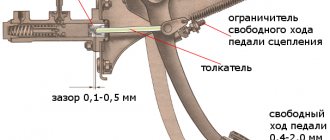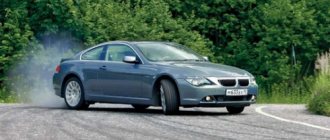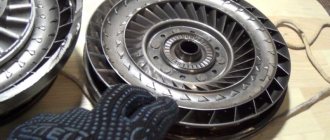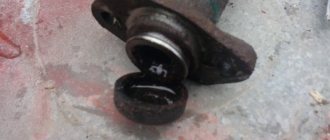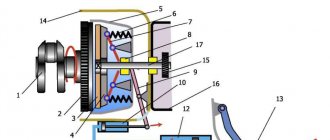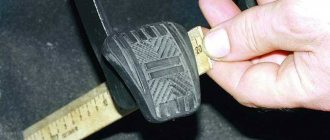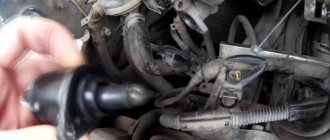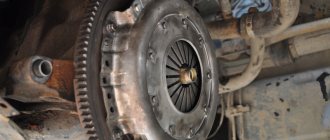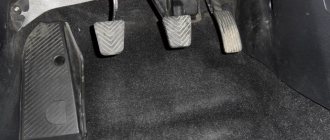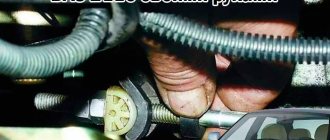What should be the free play of the clutch pedal and how to measure it
This concept means the unimpeded movement of the pedal to the actuation point. At first, the leg will not feel any resistance, but after switching on, a certain stiffness will appear. This period of “relaxation” is called free movement.
The average norm is 160 millimeters. The range of acceptable values may vary. For each specific vehicle, technical requirements may vary.
An incorrectly adjusted freewheel can cause serious problems on the road.
Clutch parts will wear out more intensively. Therefore, to prevent unpleasant situations, it is recommended to periodically check the free play.
This should be done using the following algorithm:
- Press the clutch pedal all the way by hand, measure the distance from the floor to its pad using a regular ruler, setting it strictly vertically in relation to the floor surface.
- At the next stage, you need, on the contrary, to press this element back as much as possible and make the same measurements.
- Do simple calculations. Here you just need to subtract the smaller value from the larger number. This will be the amount of free play of the clutch. The norm is 12-14 centimeters. If measurements give readings that fall outside this range, then adequate corrective measures must be taken immediately.
If the value is too high, the disc will be in constant contact with the engine flywheel. Here the clutch will not disengage completely. Under such circumstances, even releasing the pedal smoothly, the driver will not be able to move the car. Operating a car with such a defect will inevitably lead to irreversible consequences and breakdowns.
If the free stroke is small, there will be a loss of torque. Here the car, like an impatient horse, will simply tear off. On some modern cars it is structurally impossible to change the “pickup moment”. In such circumstances, you need to contact the official service.
To adjust the clutch accelerator, you need to set the desired cable length. This is required in cases where the fork free play exceeds 3 millimeters. The adjustment must be carried out using special two nuts, one of which controls the length of the cable, and the other fixes the first one in the selected position. They are placed on the threaded part of the clutch cable.
Clutch mechanism of VAZ 2107
The VAZ 2107 clutch is a rather complex mechanism consisting of several dozen elements. The reasons for its malfunction can be very different. However, they can all be divided into two groups:
- Defects in the clutch mechanism itself. These include malfunctions of the driven part of the clutch, pressure device, basket, flywheel, and clutch fork.
- Defects in the hydraulic drive of the clutch mechanism. They can be caused by leakage of the working fluid, the formation of an air lock in it, as well as malfunctions of the main or working cylinders (MCC and RCC) and the pedal mechanism.
The clutch, like any other car part, has a limited service life. First of all, it depends on the skill of the driver, and therefore is not regulated by the manufacturer. To increase the service life of the clutch, it is necessary to adjust it in time, monitor the level of working fluid, avoid off-road driving, and learn the skills of using the clutch correctly.
It must be remembered that in addition, the clutch is a safety device that protects the transmission from serious damage when the rear wheels are blocked by various obstacles. The car is stuck in a quagmire, the drive wheels are stuck, the engine power is enough to turn the stuck tires. In this case, the clutch will begin to slip, protecting the gearbox, cardan and rear axle from damage. Yes, the driven disc linings will burn out. Yes, the clutch will overheat, which can cause the steel flats to warp or weaken the spring plates. But more expensive units will be protected from breakdowns.
Classic VAZ models have a dry, permanently closed single-plate clutch . It includes two main elements:
- Leading part. It consists of a driven disk, the splined part of which transmits rotation to the gearbox due to friction between the friction linings and the surfaces of the flywheel and pressure plate.
- Non-removable drive unit (basket). The basket is attached to the flywheel and consists of a pressure plate and a diaphragm pressure spring.
The clutch mechanism must be reliable, durable, and capable of dampening fluctuations in engine torque. The clutch has a hydraulic drive consisting of:
- clutch master cylinder;
- clutch slave cylinder;
- clutch on/off forks;
- release bearing;
- foot pedal.
What if he takes it at the very top - at the beginning of the move
Here the problem is solved in a similar scenario, it’s just that the adjusting nut needs to be turned in the opposite direction compared to the adjustment procedures described above. You need to move towards the clutch pedal by turning the key in that direction.
The problem here is that the driven disk does not have the ability to fully engage. Because of this, slipping occurs, torque is lost, so the car loses its acceleration dynamics.
If you ignore this problem, then at one point the car will not even be able to move.
The hydraulic clutch requires special attention. Here you need to pay special attention to possible brake fluid leaks. Even a novice driver can adjust the free play of the pedal:
- First you need to get rid of any air that may presumably be inside the system. To do this, you need to fill the expansion tank to the recommended level. One end of the hose needs to be put on the bleeding valve, and the other should be lowered inside the can with the “brake seal”.
- After this, you need to press the clutch pedal all the way to drain the fluid along with the air.
- The next step is to tighten the valve and release the pedal.
- Finally, you need to add brake fluid to the required level.
Reasoning about alternative regulation
Before adjusting the clutch on a VAZ 2110 in the traditional way, let’s think about how justified it is, and whether there is any point in using an alternative option. According to reviews from many owners of “ten” cars, and not only them, the clutch control pedal is quite high from the floor. The inconvenience that most drivers get used to is actually quite significant.
The driver gets tired during the trip, he wants to change gears less and less, each time lifting a heavy boot. This affects not only the speed of movement, but also the condition of the transmission. Experienced drivers assure: when the clutch pedal is released, it should be positioned so that it can be depressed without lifting the heel from the floor. It’s not without reason that on UAZs and Gazelles, where adjustment is impossible, experienced drivers place a piece of board under the mat.
The clutch only engages at the very end of the pedal stroke
Boch » Sun, 05 Feb 2006, 20:29
Re: clutch on Octavia
poliglotik » Sun, 05 Feb 2006, 20:53
Is the car new or used? What is the mileage if used? If it’s used, then experience suggests that if the pedal is pressed hard and catches at the end, the clutch has another thousand left before death. On the new Octavia, I get the hang of it almost at the very beginning. On the previous Peugeot car, the clutch eventually became very heavy and grabbed almost at the very top - at the service center they took it apart and said that it was worn down to the very rivets.
PS Search by topic rules
Boch » Mon, 06 Feb 2006, 12:32
Octavia 2001, 85 tons of mileage. The clutch works great, disengaging only at the end of the stroke. The service center said that I was not the first with such a problem, they say that even on new cars such garbage occurs and cannot be adjusted. That’s why I’m asking, has anyone encountered something similar, and are there any treatment options?
AnTONIo! » Mon, 06 Feb 2006, 14:56
Vladimir » Mon, 06 Feb 2006, 15:53
Deniz » Mon, 06 Feb 2006, 16:09
Opel has the same bug...maybe it’s for the better, because... I had a new clutch set up on my Opel so that it would grab at the very beginning... it burned out after half a year. On the Audi it also caught on at the end and I drove it for 3 years before selling the car.. everything is fine. In general, the VAG clutch is very reliable
amplifier » Mon, 06 Feb 2006, 16:19
I ended up with a factory defect, a factory original clutch for AEE
poliglotik » Mon, 06 Feb 2006, 22:45
AnTONIo! » Tue, 07 Feb 2006, 11:13
Boch » Tue, 07 Feb 2006, 12:54
Thank you very much for your response. From the above, the conclusion is: You will have to get used to such a clutch!?
Zhuk » Wed, 08 Feb 2006, 14:01
Nikolay Shved » Wed, 08 Feb 2006, 17:39
SiRex » Sat, 11 Feb 2006, 13:51
I encountered this problem, but on the B5 trade winds, the clutch on them is unregulated (according to the servicemen)
A friend had an Octa 18T manual transmission with 210 hp, he drove it, the pedal grabbed at the beginning, there were no problems
Source
Reasons for replacing and adjusting the VAZ 2107 clutch
Replacing a VAZ 2107 clutch is a rather labor-intensive and expensive process. Therefore, before replacing, you should consider adjusting the mechanism.
Clutch replacement
To install a new clutch, you will need an inspection hole, overpass or lift. It is important to detect in time the signs indicating the need to replace the clutch (it is impossible to replace it on the road), and take the car to a garage or car service center. Driving with a faulty clutch is very dangerous - you can get into an accident when crossing a railway crossing or a main road.
Where should the clutch “grab”?
Where should the clutch “grab”?
Post by hav » July 27, 2012, 21:44
Post by Apolinarii » Jul 27, 2012, 10:35 pm
Post by _Vyacheslav » July 27, 2012, 10:49 pm
Re: where should the clutch engage?
Post by NoiseMouse » July 28, 2012, 01:24
Check the brake fluid level. Perhaps you need to top it up.
I am for peace, love and friendship.
Post by hav » July 28, 2012, 06:23
Post by a3tularu » Jul 28, 2012, 09:20
Post by Michel » Jul 29, 2012, 10:27 pm
And that's true.
Post by Morimoto » Oct 25, 2012 03:15 pm
Recently I began to notice that there was a noticeable jolt when changing gears. This feature arose after driving in deep snow in March and simultaneously operating the clutch pedal (in tension). Mileage 20t.km.
I was thinking about adjusting the clutch pedal. Who regulated? how it's done?
Posted by dogmos » 25 Oct 2012, 15:25
Post by brutalbever » Oct 25, 2012, 04:37 pm
Post by brutalbever » Oct 25, 2012 4:38 pm
Post by alex_xmao » 25 Oct 2012, 16:59
Post by Morimoto » 26 Oct 2012, 00:44
Posted by edx » Oct 26, 2012 10:54 am
I try not to strain the clutch too much when I start, I work with the gas a little and press it as normal after the clutch is completely released. It grabs about the middle. There were a couple of times when I had to take the six on the cable on a slight rise, when starting off up a good hill, when driving in the snow, I felt that the “grasping” place was becoming higher and more blurred or something, but after a while everything returned to normal. I always press the clutch to the floor.
Post by Mitsai » 01 Nov 2012, 14:53
Here I agree with the idea that I also want it. By the way, no one can tell you the tubers - are the officials supposed to do this?
When is it necessary to adjust the Lada Samara clutch drive?
As practice shows, the culprits of clutch failures are most often the car owners themselves. A sharp start with “slipping”, as well as prolonged holding of the pedal in a depressed state, negatively affects the performance of the mechanism. The presence of noise or vibration when shifting gears indicates a problem in the transmission line. Below are a few signs that may require adjustment:
- Loss of power due to “slipping”, i.e. unreliable connection between the disk and the flywheel.
- Difficulty changing gears.
- Changing the travel distance of the clutch pedal (the norm is from 125 to 135 mm ).
- Jerking or sticking when pressing the pedal.
Motorists who know which clutch to choose for the Lada 2114 will most likely install it together with a cable. Replacing any element of the clutch should end with adjusting the drive, as well as changing the pedal stroke.
The pedal stroke is measured with a ruler, which is pressed against the floor. The distance between the lower and upper points of the pedal position should be within 125-135 mm. The maximum permissible value is 160 mm. If the pedal stroke goes beyond these parameters, then we can talk about wear of the friction linings of the driven disk.
the clutch starts to take off right at the floor!
Go to page
runli140
Newbie
Hello forum members, I had no time to search for this topic, that’s why I’m writing here
I have the following problem: when I change gears in my car, the clutch starts to engage at the very beginning of the pedal stroke, has anyone encountered such a problem? mileage 86,000 km car - Suzuki Grand Vitara (gearbox - manual). If anyone knows, tell me how to adjust the clutch so that it engages somewhere in the middle of the pedal stroke.
lordtu
misdirected
Answer: the clutch starts to pick up right at the floor!
no problem. If the car is recent, then as long as you have a new clutch there, it will wear in on its own. (meaning that you start to let go and the car immediately starts moving) I don’t see a problem. It’s possible to adjust, but you can’t get anywhere, you can adjust the pedal travel, you just put your head under the panel with your hand, there’s an adjusting bolt above the pedal
Toha15
Advanced Beginner
Answer: the clutch starts to pick up right at the floor!
I had this problem. It turned out that the fork was broken (it was stamped). I completely changed the clutch.
krolik131287
Local
Answer: the clutch starts to pick up right at the floor!
Toha15
Advanced Beginner
Answer: the clutch starts to pick up right at the floor!
krolik131287
Local
Answer: the clutch starts to pick up right at the floor!
Happens here
Answer: the clutch starts to pick up right at the floor!
good evening I'm scratching my turnips. But isn’t it the other way around, this indicates that the clutch is worn out. I have the same situation, it starts to take 3.5 cm from the floor, according to the book they write that it should be 6 cm. I still think that this is wear on the disk. my mileage is 165 thousand km.
Added after 8 minutes
from the Legion book, the clutch pedal should be 2 cm higher than the brake pedal. I have this size. The free travel of the pedal is adjusted by the length of the master cylinder rod. I actually have it 1 cm more than normal, I haven’t bothered yet. where is the adjusting bolt, I didn’t find it
krolik131287
Local
Answer: the clutch starts to pick up right at the floor!
